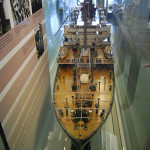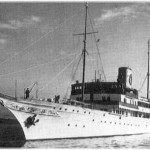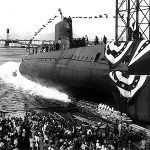After experiencing poor results early in the war, Karl Doenitz, the German U-boat fleet commander, reintroduced his “pack tactic” in the summer of 1940. It called for multiple U-boats to attack a convoy at the same time, a gathering that became known as a “wolf pack.”
The approach was simple in theory. The first U-boat to detect a convoy would alert others and shadow the formation until more U-boats could assemble for the attack. Early in the war, coordination of the attack was given to the senior U-boat commander on the scene. But this proved cumbersome and the results were disappointing.
Doenitz’s revised approach was to have his headquarters coordinate the attacks. Once a shadow boat notified headquarters of a convoy’s direction and speed, the information was relayed to the nearest U-boats. When the pack assembled (each boat reporting as it arrived on station), headquarters alerted the captains of the number of boats in the pack and give the order to attack. U-boat commanders were on their own to attack as they saw fit. The sudden free-for-all was meant to overwhelm Convoy escorts.
The success of the wolf pack was immediately apparent. From June to October 1940, U-boats sank 274 merchant ships for a total of nearly 1.4 million tons of shipping capacity. At the same time, only six U-boats were lost. The number of merchant ships sunk exceeded available replacements, a situation that, if sustained by Germany, would cut the British Isles’ lifeline. Not surprisingly, the period came to be known as “the happy time” for the U-boat fleet.
To achieve its ultimate goal, the wolf pack tactic required construction of many more U-boats and relied on the coded messaging between fleet headquarters and boats at sea provided by the supposedly unbreakable Enigma encryption device.
To answer the first need, U-boat construction was ramping up. By the end of 1941, Doenitz would have 91 operational U-boats. That year, they managed to sink 432 ships amounting to more than two million tons of capacity lost. The number of available U-boats would more than double in 1942, but the tonnage of ships sunk did not keep pace.
The ratio of merchant shipping losses did not continue to grow as the number of U-boats increased, because of several factors. The supposedly unbreakable Enigma device was compromised in mid-1941. British intelligence operatives received a huge boost in breaking the code when the Royal Navy captured an Enigma machine and vital code books from a sinking U-boat. (See blog “Enigma’s Mysteries Revealed,” Oct. 2, 2018.) At the same time, British convoy escorts were devising new, more effective counter measures to deal with wolf packs. And in December of 1941 the United States entered the war following the Japanese attack on Pearl Harbor.
We’ll have more about these developments in our next blog.





